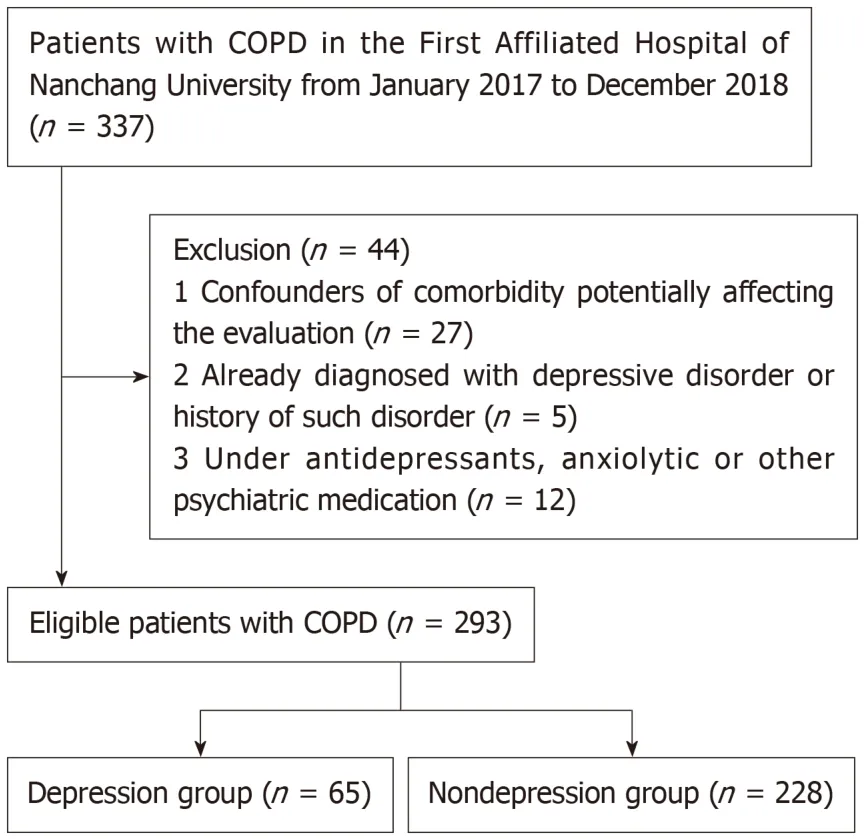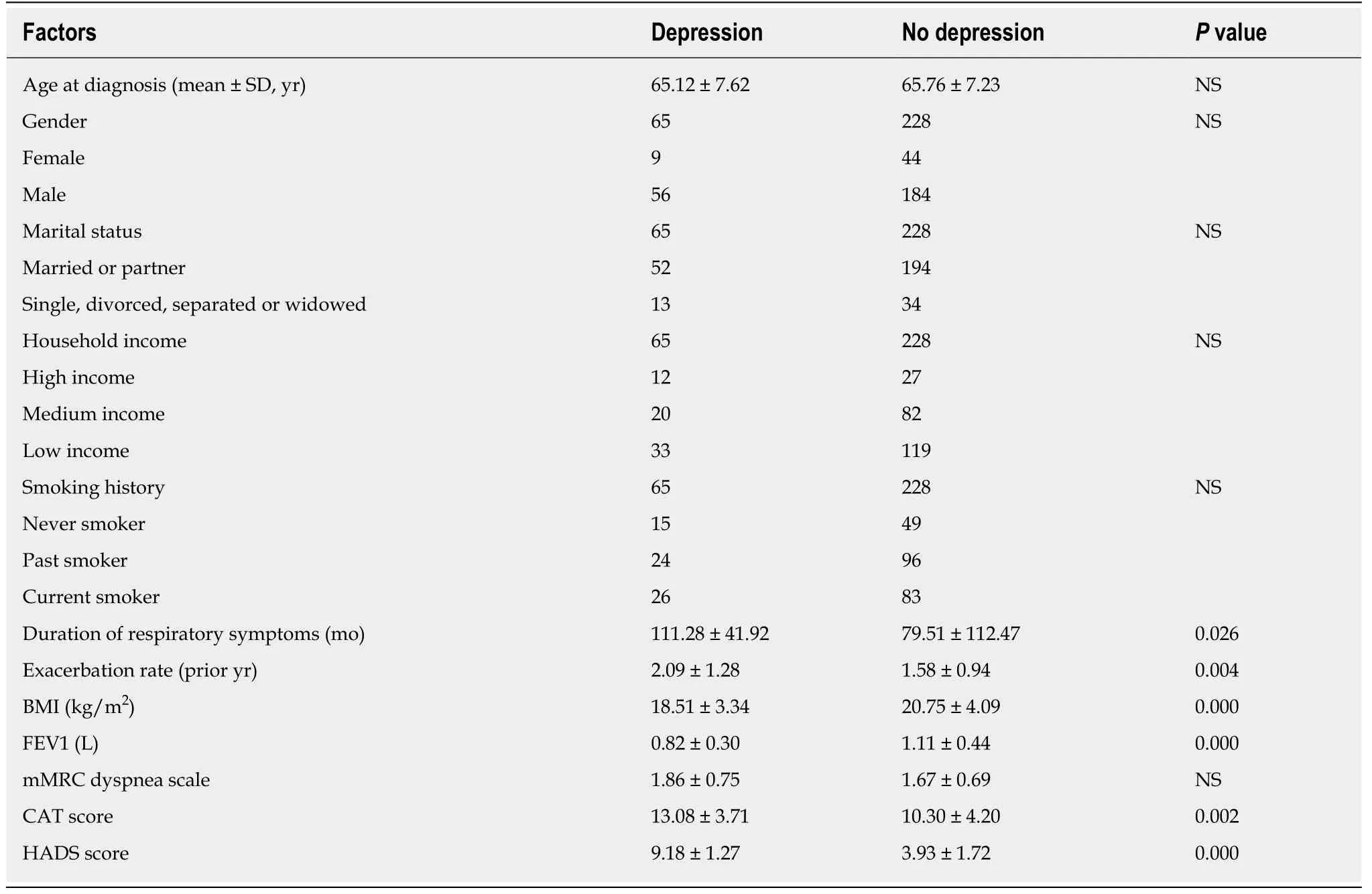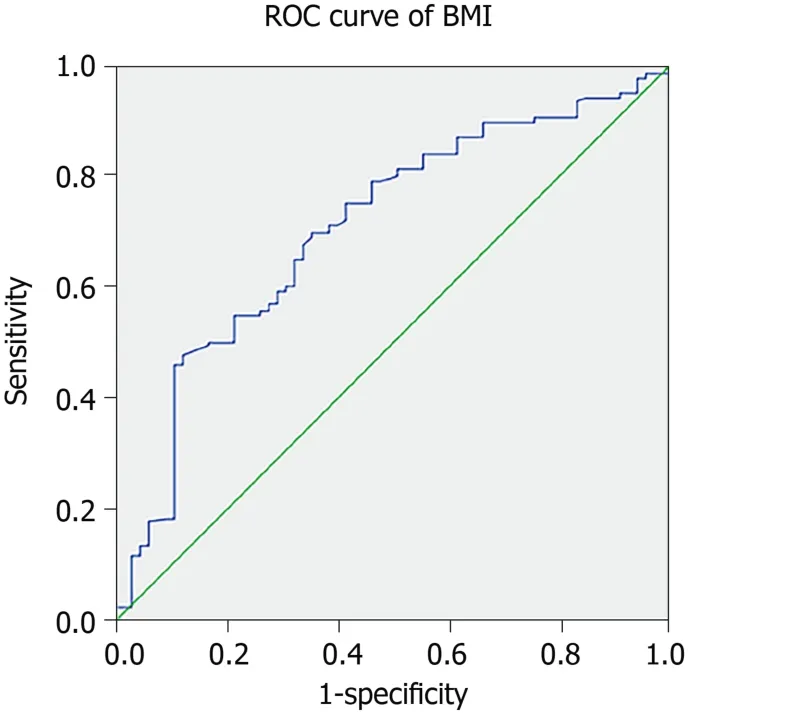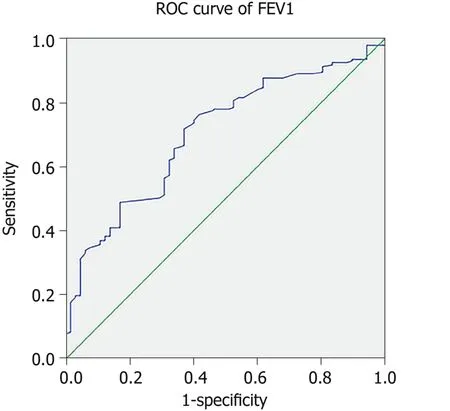Risk factors for depression in patients with chronic obstructive pulmonary disease
Hui-Ming Yao,Ren-Sen Xiao,Wei Zuo,Wei Zhang,Department of Respiratory and Critical Care Medicine,The First Affiliated Hospital of Nanchang University,Nanchang 330006,Jiangxi Province,China
Ping-Liang Cao,Xiao-Lei Wang,Second Department of Cardiovascular Medicine,Jiangxi Provincial People's Hospital Affiliated to Nanchang University,Nanchang 330006,Jiangxi Province,China
Abstract
Key words:Depression;Chronic obstructive pulmonary disease;Body mass index;Forced expiratory volume in 1 second;Chronic obstructive pulmonary disease assessment test scores;Risk factors
INTRODUCTION
Chronic obstructive pulmonary disease (COPD) is a leading cause of morbidity with an economic and social burden that is both substantial and increasing[1,2].COPD is currently the fourth-leading cause of death and is expected to surpass stroke within the next decade to become the third leading cause of death[3].Because medical treatments have made limited inroads,patients with COPD experience recurring acute exacerbations,frequent hospital admissions,poor survival,and impaired physical functioning and quality of life[4-6].The reported prevalence of depression in patients with COPD ranges from 10% to 42%,a proportion much higher than that in the general population[7,8].Although evidence suggests that certain interventions such as antidepressants,pulmonary rehabilitation,and counseling may improve health outcomes,the diagnosis of depression in patients with COPD is often unrecognized and untreated in primary and specialty care[9,10].Unrecognized depression has major implications for compliance with medical treatment,prolonged lengths of stay,increased frequency of hospital admissions,and increased consultations with primary care physicians,all of which could decrease quality of life in patients[11,12].The Hospital Anxiety and Depression Rating Scale (HADS) is one of the most commonly used instruments for depression in the literature[13].The HADS is subjective and is intended for anxiety and depression screening of patients in general hospitals.It is a 14-item self-report questionnaire comprising two subscales:HADS-anxiety subscale (HADSA) and HADS-depression subscale (HADS-D),which are scored from 0 to 21 to detect the presence of symptoms of anxiety and depression.The scale is designed for use in patients with physical illness;therefore,none of the items include somatic symptoms of depression or anxiety.Although the screening tool is widely available,it cannot provide enough information for early diagnosis.
Many studies have attempted to identify risk factors for progression,prognosis and response to therapy in patients with depression[10,14].However,few studies have examined the risk factors for depression in patients with COPD,and some results remain controversial[14].Thus,further research is needed to detect depression in patients with COPD for early diagnosis and treatment.The purpose of the current study is to investigate the correlation between clinical parameters and the symptoms of depression,and to identify independent risk factors to define patients with COPD at “high risk” of depression.
问:我奶奶85岁,有痔疮而且腹泻严重,几乎吃点东西就要上厕所,肚里存不住东西,这样对老人身心健康不利,家人很担心,去医院也查不出什么问题。请问杨老师如何治疗,或是吃点什么补品?
MATERIALS AND METHODS
Patients
This was a retrospective study with no involvement in clinical or animal research.The requirement for ethical permission was waived according to the statements regarding the application of ethical permission by the Ethical Committee of the First Affiliated Hospital of Nanchang University.A retrospective study was conducted and a series of consecutive patients newly diagnosed with COPD between January 2017 and December 2018 were included in this study.COPD diagnosis was made according to the Global Initiative for Chronic Obstructive Lung Disease[15].We studied the files of the patients carefully to ensure that all factors that might affect the outcome of the assessment were considered when the patients were included in this study.Standard treatment was given to each patient.The diagnosis of depression mainly relied on the HADS-D,and the HADS scale was carried out by an experienced psychiatrist when the patients were stable.A review and meta-analysis of studies reported that a cutoff of 8 or more on the HADS-D produced a sensitivity of 0.82 (95%CI:0.73-80) and a specificity of 0.74 (95%CI:0.60-0.84) for depressive disorders[16].Therefore,we used a cutoff of 8 or more on the HADS-D to dichotomize the HADS-D scores for the purposes of the regression analyses.All the patients were inpatients and were recruited from medical hospital wards.
Patients presenting with confounders of comorbidity or other conditions that could potentially affect the evaluation of risk factors,such as dependent care living situations,life expectancy of less than six months,trouble with eye-sight,and diagnosis of dementia or Alzheimer's disease,were excluded from this study.For patients already diagnosed with depressive disorder or history of such disorder,only those with depression associated with COPD were included in this study and the judgments were made by an experienced psychiatrist.Patients receiving antidepressants,anxiolytics or other psychiatric medication were excluded in order to avoid introducing bias as treatment options might have a potential impact on HADS scores.
Data collection
The demographics and clinical characteristics of the patients in this retrospective study included age,gender,marital status,household income,smoking status,duration of respiratory symptoms,number of acute exacerbations in the previous year,body mass index (BMI,kg/m2),forced expiratory volume in 1 s (FEV1,L),and Modified British Medical Research Council Questionnaire (mMRC) and Chronic Obstructive Pulmonary Disease assessment test (CAT) scores at the time of the primary diagnosis of COPD.The correlation between clinical parameters and depression was analyzed,and the risk factors for depression in patients with COPD were identified.
Statistical analysis
All analyses were performed using IBM SPSS Version 22 (SPSS Inc.Chicago IL,USA).Qualitative variables were expressed as numbers and percentages,and were assessed by theχ2test or Fisher's exact test.Continuous variables were reported as the mean ±SD and were compared with independent samplest-tests or univariate analysis.Independent risk factors related to depression were analyzed using a multivariate logistic regression analysis model.A receiver operating characteristic (ROC) curve was used to assess the predictive value of risk factors in patients with depression.Statistical significance was set as aPvalue less than 0.05.
RESULTS
Patient demographics
A total of 293 patients with COPD were included in this study (Figure 1).Patients'demographics are shown in Table 1.Of the 293 patients who were eligible for inclusion,65 individuals were identified to have depression.The overall incidence of depression in this study was 22.18% (65/293).Most of the patients were male (240 patients,81.91%),with an average age of 65.62 ± 7.31 years.Among these patients,38.91% were past smokers,and 33.79% were current smokers.The household income type of most patients was low income (149 patients,50.85%) or medium income (105 patients,35.84%).
The correlation between diverse clinical factors and depression
The differences between clinical parameters and depression were investigated and the results are presented in Table 2.The results revealed that depression in patients with COPD was associated with the duration of respiratory symptoms,the number of exacerbations per year,BMI,FEV1,and the mMRC dyspnea scale and CAT scores as significant differences were found between patients with and without depression for these factors (allP< 0.05).These results indicated that the duration of respiratory symptoms,the number of exacerbations per year,BMI,FEV1,and the mMRC dyspnea scale and CAT scores were potentially related to depression in patients with COPD.No statistically significant differences in age,gender,marital status,household income and smoking history were observed between the 2 groups (P> 0.05).
Risk factors for depression in patients with COPD
Multivariate logistic regression analysis was carried out to identify the potential risk factors for depression in patients with COPD.Low BMI (OR = 0.893,P< 0.05),low FEV1 (OR = 0.325,P< 0.05),and high CAT score (OR = 1.111,P< 0.05) were independent risk factors for depression.No significant differences were found for the duration of respiratory symptoms or the number of exacerbations per year between COPD patients with and without depression (P> 0.05) (Table 3).
The cutoff value,sensitivity,and specificity of BMI,FEV1,and CAT score for diagnosing depression
Figure2,Figure 3 and Figure 4 show the ROC curves of BMI,FEV1,and CAT score for predicting the risk of depression;these factors had comparable accuracy in predicting depression in COPD patients (the AUC of these factors were 0.705,0.702 and 0.694,respectively).The cutoff values of these factors were 21.375 kg/m2,0.855 L and 12.5,respectively.BMI had the highest diagnostic accuracy for predicting the risk of depression (AUC = 0.705,P< 0.05),with a sensitivity and specificity of 49.6% and 83.1%,respectively.Additionally,combined BMI and FEV1 with CAT score had a higher AUC (BMI + FEV1:74.5%;BMI + CAT:73.5%;FEV1 + CAT:73.0%;BMI +FEV1 + CAT:76.6%) than that of one single factor (Table 4).
DISCUSSION
COPD is a major respiratory noncommunicable disease and is currently the third leading cause of death worldwide[17].Depression occurs in up to 42% of persons with COPD[11],almost twice as often as in those without COPD[18].In line with previous studies,the incidence of depression in our study was 22.18%,based on a population of 293 patients.Depression in patients with COPD is associated with physical impairment[19],readmission[20],increased dyspnea[21,22],and mortality[23].Due to the considerable overlap between the physical symptoms of depression and the symptoms of COPD,patients with COPD may not be able to recognize this mental illness,and diagnosis is easily missed by doctors compared with that in patients with other comorbidities or depression alone[24].Due to these factors,depression may reduce patient compliance with COPD treatment,thus leading to deterioration related to COPD.Therefore,identifying valuable predictive factors that are readily available could meaningfully benefit timely intervention to cure depression.In this retrospective study,we evaluated the association between clinical factors and depression in patients with COPD.Previous studies reported that depression in patients with COPD was associated with multiple factors,including age,gender,marital status,smoking history and social performance[25-27].However,in this study,a correlation between the above-mentioned factors and depression was not found.The reason for this result may be that these studies were performed primarily in patients with severe COPD,and few of them focused on risk factors in patients with mild COPD.
BMI had been widely used to measure obesity,and there is growing evidence that BMI is an independent predictor of mental disorders[28].A previous study reported that the average depression score in an obesity group was higher than that in a normal BMI group[28].Zhaoet al[29]revealed that obese individuals (≥ 25.0 kg/m2) were 38% more likely to experience depression,and were 40% more likely to have lifetime depression after fully adjusting for several factors,such as obesity-relatedcomorbidities,demographics,and psychosocial factors.Leeet al[30]indicated that adjusted odds ratios for depression formed a U-shaped relationship with BMI categories (underweight group:1.31,overweight group:0.94,obese group:1.01,severely obese group:1.28).The BMI level with the lowest likelihood of depression was 18.5-25 kg/m2in women and 23-25 kg/m2in men[30].However,few studies have analyzed the relationship between BMI and depression in patients with COPD.In the current study,we identified BMI as an independent risk factor correlated with depression.The cutoff value was 21.375 kg/m2.This finding suggested that BMI levels< 21.375 kg/m2could help to distinguish populations of patients with COPD at a higher risk of depression.

Table1 Baseline characteristics of patients,n = 293 (%)
Previous data highlighted the association between FEV1 and depression.A study reported that among 100 dairy farmers with COPD,as defined by a postbronchodilator FEV1/forced vital capacity ratio < 0.7,depression in patients was associated with lower FEV1,as well as with certain COPD-related characteristics(current smoking,dyspnea severity,and poorer quality of life)[31].Von Siemenset al[32]demonstrated that FEV1 was significantly (P< 0.05) related to the Patient Health Questionnaire 9 score,which is one of the screening tools for depression.Significant differences were found for FEV1 levels,reflecting COPD severity,between patients with and without depression[33].This result could help patients with depression avoid being untreated or undertreated[34].Consistent with previous studies,our study indicated that FEV1 was an independent risk factor for depression in patients with COPD.The cut-off value was 0.855 L,and the sensitivity and specificity were 71.5%and 63.1%,respectively.
The CAT score was developed in 2009 as a patient-administered,short questionnaire to test health-related quality of life in patients with COPD[35].Lower scores indicated less severe symptoms.There was a significant difference in CAT scores between patients with depression and without depression[35].The analyses by von Siemenset al[32]revealed,with a cut-off CAT score of 20,an AUC of 0.81.Based on the close relationship between the tests,the CAT score and depression were also omitted from further analysis.Interestingly,this value was similar to the critical value of 18,which had been proposed to be better than the conventional threshold of 10 in terms of the classification of COPD severity.Leeet al[36]indicated that the CAT score and symptoms were correlated with the formation of depression in patients with COPD.In line with previous studies,the results of our study showed significant differences in CAT scores between patients with and without depression,and we identified that the CAT score was an independent risk factor correlated with depression.The cutoff value was 12.5.This finding indicated that a CAT score > 12.5 was a risk factor for depression in patients with COPD.
To identify the predictive accuracy of combined risk factors for predicting depression in patients with COPD,we analyzed the combined risk factors for depression in the present study.Compared to BMI,FEV1 or CAT score alone,we found that combining FEV1 and CAT score with BMI had higher predictive value for predicting depression in patients with COPD.This finding indicated that the combination of risk factors appeared to be more useful for predicting depression.

Figure1 Selection of the study participants.
To our knowledge,we have been successful in identifying low BMI,low FEV1 and high CAT score as independent depression associated risk factors in patients with COPD.Although the results are interesting,limitations to our study still exist.First,this was a retrospective study with a relatively small sample,which may have resulted in bias during analysis of the results.Second,we only collected variables from patients with COPD at the time of diagnosis,and some variables,such as the time to depression and follow up,were not reported.Third,patient variables were from a single medical institution and the results of our study for predicting depression were not satisfactory.Thus,a multicenter study with more patients is needed to verify our results.Fourth,some studies indicated that the HADS was saturated by the presence of a common distressing factor,in part because it was intended to focus on lack of pleasure and autonomous arousal,leading to the difficulty in distinguishing depression from anxiety.This explained the result that the HADS anxiety scale and depression scale served the same purpose as a screening tool for depression[37].For research purposes,the use of a summed HADS total score was recommended and appeared to provide an adequate estimate.In clinical practice,HADS is not recommended when it is necessary to distinguish between anxiety and depression.Due to its poor trait coverage and narrow focus,short tools covering broad anxiety and depression symptoms may be more appropriate[38,39].COPD patients have greater disease burden than other populations.In addition to the widespread symptoms of depression,our results also identified several risk factors for depression including low BMI,low FEV1,and high CAT score.However,barriers to recognition exist at the provider and system levels.At the provider level,lack of ambitions and stereotypes can be obstacles.At the system level,poor integration of mental health services with primary health care is another obstacle.
In conclusion,based on this analysis,we established that approximately one-fifth of patients with COPD developed depression.Additionally,we identified low BMI,low FEV1,and high CAT score as risk factors for depression in COPD patients.Combining these factors predicted the highest risk of developing depression.However,a prospective study with a large sample size and multicenter analysis is needed to prove the conclusions of our study.

Table2 Correlation between diverse clinical factors and depression

Table3 Multivariate logistic regression analysis of risk factors

Table4 Cutoff value,sensitivity,and specificity of body mass index,forced expiratory volume in 1 s,and chronic obstructive pulmonary disease assessment test score for diagnosing depression

Figure2 Receiver operating characteristic curve of body mass index.

Figure3 Receiver operating characteristic curve of forced expiratory volume in 1 s.

Figure4 Receiver operating characteristic curve of chronic obstructive pulmonary disease assessment test score.
ARTICLE HIGHLIGHTS
Research background
The reported prevalence of depression in patients with chronic obstructive pulmonary disease(COPD) ranges from 10% to 42%,a proportion much higher than that in the general population.Certain interventions such as antidepressants,pulmonary rehabilitation,and counseling may improve health outcomes,but the diagnosis of depression in patients with COPD is often unrecognized and untreated in primary and specialty care.Unrecognized depression has major implications for compliance with medical treatment,prolonged lengths of stay,increased frequency of hospital admissions,and increased consultations with primary care physicians,all of which could decrease quality of life in patients.
Research motivation
Many studies have attempted to identify risk factors for progression,prognosis and response to therapy in patients with depression.However,few studies have examined the risk factors for depression in patients with COPD,and some results remain controversial.
Research objectives
The main objective of the current study is to investigate the correlation between clinical parameters and the symptoms of depression,and to identify independent risk factors to define patients with COPD at “high risk” of depression.
Research methods
The Hospital Anxiety and Depression Rating Scale (HADS) is one of the most commonly used instruments for depression in the literature.A series of consecutive patients newly diagnosed with COPD were included in this study.The diagnosis of depression mainly relied on the HADS,and the HADS scale was carried out by an experienced psychiatrist when the patients were stable.We used a cutoff of 8 or more on the HADS to dichotomize the HADS scores for the purposes of the regression analyses.The correlation between clinical parameters and depression was analyzed,and the risk factors for depression in patients with COPD were identified.
Research results
Multivariate logistic regression analysis was carried out to identify the potential risk factors for depression in patients with COPD.Low body mass index (BMI),low forced expiratory volume in 1 s (FEV1),and high COPD assessment test (CAT) score were independent risk factors for depression.BMI had the highest diagnostic accuracy for predicting the risk of depression.Additionally,combined BMI and FEV1 with CAT score had a higher area under curve than that of one single factor.
Research conclusions
Approximately one-fifth of patients with COPD developed depression.Additionally,we identified low BMI,low FEV1,and high CAT score as risk factors for depression in COPD patients.Combining these factors predicted the highest risk of developing depression.
Research perspectives
Some variables,such as the time to depression and follow up,were not reported,which may have resulted in bias during analysis of the results.A prospective study with a large sample size and multicenter analysis is needed to prove the conclusions of our study.
 World Journal of Psychiatry2020年4期
World Journal of Psychiatry2020年4期
- World Journal of Psychiatry的其它文章
- Evidence for using dextromethorphan-quinidine for the treatment of agitation in dementia
- Moderators and mediators of antipsychotic response in delusional disorder:Further steps are needed
- Comparison of novel tools with traditional cognitive tests in detecting delirium in elderly medical patients
- Diagnostic accuracy and clinical utility of non-English versions of Edinburgh Post-Natal Depression Scale for screening post-natal depression in lndia:A meta-analysis
